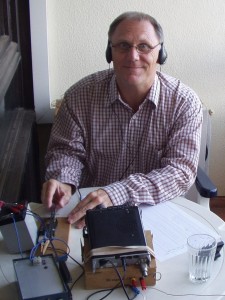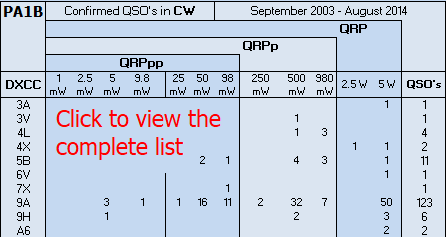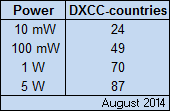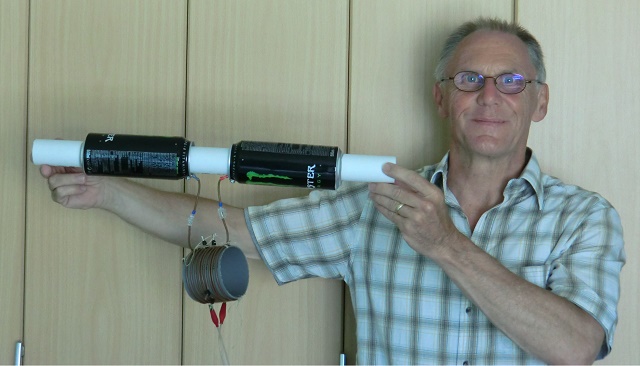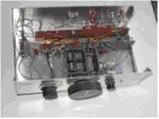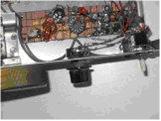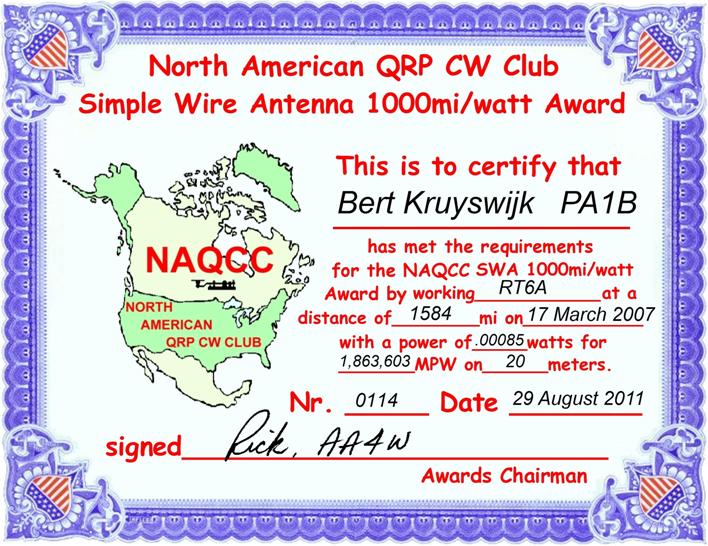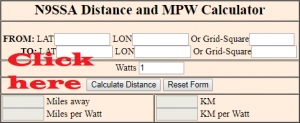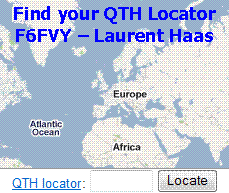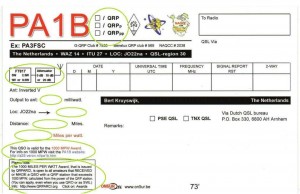PA1B’s QRPp page
My name is Bert and my call is PA1B.
I made this PA1B’s QRPp page, to show how I operate with the Lowest Possible Power in CW contest QSO’s.
In many contest QSO I use the lowest possible power.
Rig
In most QSO’s I use my FT-817 with a CW filter with a bandwidth of 500 Hz.
Lowest possible power
When I work with the lowest possible power, I always answer a CQ. Thus I use Search and Pounce (S&P). Before I answer a CQ, I chose the power that I will use.
The higher the S-meter reading, the better the propagation, the lower the power that I can use.
I answer a CQ, by sending my call just once or twice. I only increase my power, when I am sure that my signal is not heard. When I increase my power, I always take a step of 3 dB or 4 dB.
When my signal is heard, most of the time, I will get an immediate correct response. Hi.
I made contest QSO’s from 5 watt down to 1 milliwatt. Hi.
Very low power
In many contest QSO’s I use 500 mW or 1 watt, when the received signals are S9. My signal will be S5.
A contest station will work every one, also when the signal is not an ear splitting S9. Hi.
When the condition go up and the signal strength of the received signal is S9 + 10 dB, I can reduce my power with 10 dB. Then I reduce my power to 100 mW or 50 mW, using PA1B accurate homebrew attenuator between the set and the tuner.
Antenna’s
Up to 2015 I used an Inverted Vee, that I used since I started as a HAM.
Since May 2015 and in 2016, I also use indoor cylinder dipoles of 12 inch and 15 inch on 21 MHz and 14 MHz, in stead of the inverted V.
From 2017 I use an end fed with linear loading, that is fed via twin lead. This antenna works without a groud system, because the not connected wire of the twin lead acts as a counter poise.
List of QSO’s with very low power
As an low power enthusiast, I have made a lot of CW QSO’s with QRP and QRPp down to a few milliwatt. When I use low power, I always answer a CQ. This is called S&P (search and pounce).
I only increase my power, with a step of 3 dB or 4 dB, when I am sure that my signal is not heard.
I am proud to present a long list of more than 75 Confirmed DXCC countries.
My interests as a HAM
- To participate in radio contests in CW with QRPp or QRP on HF
- DXCC hunting with 100 milliwatt or less
- 1000 Miles per Watt
- Design of accurate power attenuators
Cylinder dipole
The cylinder dipole has proven to be a very small indoor HF-antenna. The cylinder dipole with two Monster energy drink cans and a coil is easy to build and is working fine on 15 m.
I have a lot of fun in QRP CW contest QSO’s with this cylinder dipole in the shack at the first floor, just 4 meter above the ground. With this indoor cylinder dipole I worked many DXCC countries all over Europe.
The efficiency of the Cylinder Dipole with Monster Energy Drink Cans is remarkably good (75%) for a antenna with a wingspan of 2.5% of the wavelength.
PA1B Power Attenuators
In the PA1B Power attenuators, I use two or more resistors from the E12-series in parallel, to design very accurate attenuators, that can handle much more power.
By using resistors in parallel, rather than in series, the circuit of the attenuator remains very simple.
With two or more resistors from the E12-series in parallel, you can make any value.
10 dB Power Attenuator

5 Watt Nominal Input power
with resistors of 1 W

Power distribution in a 10 dB section
PA1B Power Attenuator Calculator
This calculator in an Excel sheet enables you, to design a very accurate power attenuator for any power you want.
So you can reduce the power of your set to QRPp level with out modifying the set.
All attenuators on this web site are developed with this unique PA1B Power Attenuator Calculator.
The three fundamental resistors that form a Pi-type power attenuator, are each composed of a number of resistors in parallel.
In the parallel circuit the power is distributed over the resistors.
The higher the power, the more resistors are required.
I developed the calculator for attenuator sections 1 dB, 2 dB, 3 dB, 7 dB, 10 dB or 20 dB.
The use of an attenuator in QSO’s with very low power.
When the propagation is very good to extremely good and the received signals are S9 plus 10 dB or more, CW QSO’s can be made with 100 mW or 50 mW.
I use an accurate attenuator, that is placed between the set and the transmatch (tuner), to make CW QSO’s with less than 500 mW.
The PA1B Attenuators are built with resistors, from the E12-series and are very accurate. Using very low power is great fun.

FT-817 with attenuator
WSPR with an attenuator
Reduce your power to 10 mW or even 1 mW, to make WSPR-spots, that can be compared with a SSB signal of 4 W or 400 mW.
Use WSPR as a beacon, in stead of broadcasting with WSPR, with much more power than is needed. Hi.
Improve the usefullnes of your WSPR beacon, by reducing it’s power.
So it will only be spotted with good or very good propagation.
Power Attenuator and Audio reduction
Use a simple attenuator, combined with a reduction of the audio signal, to use WSPR with 10 milliwatt. Hi.
WSPR with 10 milliwatt
The Lowest Possible Power diagram reveals the propagation instantly.

Lowest Possible Power diagram
The lower the Lowest Possible Power,
the better the propagation.
Look at this interesting Lowest Possible Power diagram.
Spots A to F show that the propagation is very good, because these spots are in the light grey area of very good propagation.
Spot F is made with 10 milliwatt.
The spots A to E are made with 5 W to 200 mW. The Lowest Possible Power diagram shows, that spots A to E could also have been made with just 10 milliwatts.
You don’t need much power for your WSPR station, when the propagation is very good.
- Use WSPR as a propagation beacon
- Avoid de-sensing of distant WSPR receivers, with more power than is needed
- Avoid clutter spots with 5 watt
This is a unique attenuator with excellent accuracy
This step attenuator with steps of 1 dB is very accurate. The attenuator is ideal for accurate measurements. The accuracy of section of 20 dB is ± 0.05 dB. Which is just as accurate as professional measuring equipment.
This attenuator with excellent accuracy, is built with good available resistors of 2 watt and resistors of 400 mW from the E12-series.
Notice the unique properties of the combination of 3 dB and 7 dB.

43 dB step attenuator with steps of 1 dB – PA1B
This attenuator is more accurate than the 41 dB Hendriks attenuator.
PA1B Fast and accurate 40 dB Power Attenuator for QSO’s
A simple way to reduce the power of your QRP set to milliwatt level, without modifying the set, is the use of attenuators. The combination of 3 dB, 7 dB, 10 dB and 20 dB, is fast to switch, when you want to increase your power in QSO’s. In one move, one attenuator section is switched ON and an other is switched OFF, to increase the power with a step of 3 db or 4 dB.

Very fast and accurate 40 dB attenuator for QSO’s – PA1B
Power Attenuators for the FT-817
Reduce your power level to QRPpp (less than 100 milliwatt), without modifying your FT-817. This attenuator is very accurate and easy to built, with good available resistors from the E12-series.
For WSPR with very low power I suggest to use resistors of 1 watt. The nominal input power will be 750 mW (3 W max.). With resistors of 1/2 W, the nominal input power is 375 mW. (1.5 W max.).
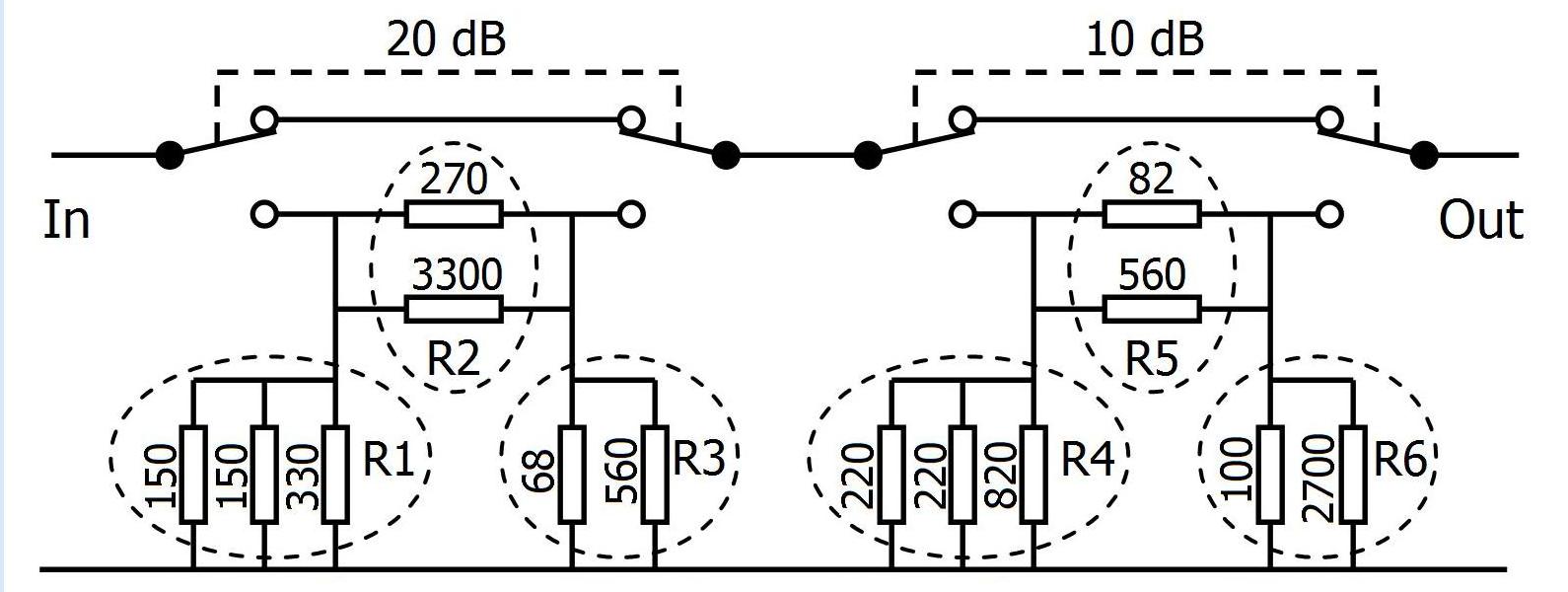
20 dB and 10 dB Attenuator for the FT-817
Read the interesting article published in SPRAT 152
Lowest possible power
In many contest QSO’s I try to use the Lowest Possible Power in each QSO. In most QSO’s I answer a CQ, instead of calling CQ myself. First I adjust to a power that is probably just high enough to make the QSO. I answer by giving my call just once or twice. Then I listen. When the station is still calling CQ after my call, my signal is not heard.
Only when I notice that my signal is not heard, I increase the power and try again. Each time the calling station answers an other station, I wait patiently.
The frequency must be absolutely clear for my signal to be heard. With many other callers in a contest, this can be take some time (hi). But many times, suddenly when I am the only station calling, the station repeats my call, immediately correct and gives his report. Fortunately I always receive 599. (hi) After sending my exchange, I can log the QSO.
By operating in such a way, I have great fun with very low power and at the same time I develop my operating skills.
Sometimes I start with a power that is probably to low, because in a contest I can not make a second QSO with the same contest station, with a lower power.
In my log I note my power in every QSO. In my log I also have special columns for ”miles” and ”Miles per Watt”
I always use QRP, but I never use the tag /QRP in a contest QSO. I rather use the time to send my call twice, than to give /QRP.
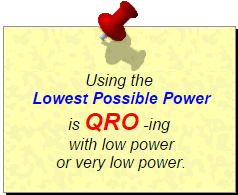
QRO means: Increase power
QRPp how is it possible?
A CW signal with a signal strength of S9 is very strong. But a signal with S5 or even lower can be received easily. If a station, that is transmitting with 100 W, is received with a signal strength of S9, then my 500 mW signal will be received with 559. This is 4 S-point down. The signal will not be very strong, but the readability will be good.
When the propagation is good to extremely good, the signal of the 100 W station will be S9 + 10 dB, so I can reduce my power to 50 mW, using an attenuator of 10 dB and still be received with 559. hi.
When I increase my power, when my signal is not heard, I usually “double” the power. Then I try again. A step of 3 dB or 4dB is the optimal step to increase the power.
I noticed in many QSO’s “on the edge“, that when I was heard, but my call was not copied even after repeating 10 times, that my call was immediately copied correct with the doubled power. A step is 1 dB is too small and a step of 10 dB is too large. The steps of 3 dB or 4 dB are an excellent choice of the designers of the Yeasu FT-817.
When I use an attenuator, I transmit and listen through the attenuator.
Depending upon the signal strength of the received signal, I use QRP, QRPp or QRPpp. QRP means using a power of 5 watts or less in CW (or 10 watts in phone). QRPp is less then 1 watt, also called milliwatting.
QRPpp is the (not official) term I use for a power less than 100 mW. This is also known as ”two digit milliwatting”.

100 W to 500 mW is 4 S-poins
PA1B’s QRPp Blog
In addition to this PA1B QRPp page, I started the PA1B’s QRPp Blog, which also gives room for comments. In this Blog I give current information. I can update the Blog at any moment. At the top of the Blog you can find TABs on interesting, “timeless” topics.
Some of my homebrew equipment
Building and operating with homebrew equipment is great fun. Click on a picture to select my homemade equipment.
In special contests as the OQRP contest, I use my homebrew CW transceivers HM7, and HDC14.
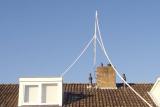
Inverted V >>
Read the interesting story on my holiday transmatch and the Award from Portugal.
Click on the pictures or the links to see the equipment or antenna.
1 milliwatt QSO’s
Over the years I made many QSO’s with very low power. But I only made a few QSO’s with 1 milliwatt. The QSO’s with RT6A over more than 1500 miles and with RU1A over more than 1000 miles, are both good for more than ONE MILLION miles per watt.
NAQCC 1000 Miles per Watt Award
For years I am a member of the NAQCC. (#2038) The NAQCC club activities are dedicated to QRP/QRPp operation, using CW. When I visited the Award page in August 2011, I got excited by the extensive Award program for QRP and QRPp.
Over the years I have made hundreds of confirmed QSO’s with more than 1000 Miles per Watt, but until now, I had not yet applied for an award. So I decided to apply for the 1000 MPW Award.
I choose to apply for the QSO with the highest Miles per Watt. This QSO with RT6A was made in the Russian DX contest in August 2007.
A few days later, I received the beautiful NAQCC Simple wire antenna 1000 Miles per Watt Award, sent by e-mail, from the Award manager, Rick AA4W.
Check out the interesting Award info of the NAQCC
PA1B – 1000 MPW # 114
1000 MPW QSO’s
After many QSO’s with 50 mW or less, I realized that I had breached the ”1000 Miles per Watt boundary” many times. Using very low power, I make many QSO’s with more than 1000 Miles per Watt.
From The Netherlands to Germany over more than 50 miles, with 50 mW or to France over more than 100 miles, with 100 mW is good for ”more than 1000 Miles per Watt”.
The lower the power the higher the Miles per Watt score. hi
Any QSO from the Netherlands to Canada or the USA with 2.5 W is a “more than 1000 Miles per Watt QSO”. And also a QSO with 1 watt to Moscow over 1300 miles will do.
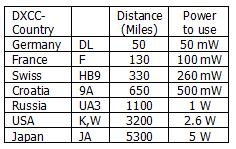
The lower the power the higher the Miles per Watt score
Reduce you power and enter the amazing world of “1000 MPW”.
Calculate your Miles per Watt.
Calculate the distance with the fantastic “Miles per Watt calculator” by N9SSA.
Copy the two QTH locators and paste them, one by one, into the fields ”Grid-Square”.
Fill in the power in the field ”Watts”. (give 0.05 for 50 mW)
My QTH locator is JO22na
If you are interested in Miles per Watt – I found a the N9SSA Distance and MPW calculator on the QRZ.COM.hr page by Miša, 9A4TA
Determine your QTH
First determine your QTH locator with the excellent:
Find your QTH locator by F6FVY Laurent Haas.
Zoom in on your city and then click on your street to find your QTH locator.
My 1000 Miles per Watt QSL card
For more than five years, I send a special ”more than 1000 Miles per Watt QSL card”, for many ”more than 1000 Miles per Watt” QSO’s that I make.
Clikc to see all the interesting detail of my special 1000 Miles per Watt QSL Card
The QRPARCI ”1000 MILES PER WATT” AWARD
If the calculation gives more than 1000 Miles per Watt you can apply for the 1000 Miles per Watt Award that is issued by QRPARCI.
This Award is issued to amateurs that RECEIVED or MADE a QSO with a QRP station that exceeds 1000 Miles per Watt, calculated from the power of the QRP station. You can apply, even when you are using QRO or as SWL.
Learn here more about the rules for the Awards >> of QRPARCI.
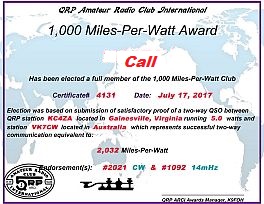
QRPARCI 1000 MPW Award
How I started
When I started as a HAM on HF, I built my first transceiver myself. I had great fun with this homebrew CW QRPp transceiver the (HM7 >>). The rig comes from “Solid State Design for the radio amateur” page 214…218. In the 10 years that I used this CW transceiver, I worked many European countries on 7 MHz with a power of only 500 milliwatts in many normal QSO’s and many contest QSO’s. Homebrew, QRP and CW (Morse code >>) is a fabulous combination.
After I had worked with this transceiver (HM7) for a half year, I met Piero I5FPJ from Florence. After I mentioned that I worked with 1 watt, Piero reduced his power. I noticed, that when Piero went from 100 watts to 3 watts (-15 dB), the signal was less loud, but the readability of the signal was still good. Only the background noise was stronger. When Piero went from 3 watts, via 2 watts to 1 watt (-5 dB), I noticed that the signal strength only reduced a little bit. And when we were both running 1 watt, the signals were still good, with only more noise in the background. With this knowledge, I reduced the power of the HM7 from 1 watt to 500 milliwatt, a few months later.
.In 2001 I bought a Yaesu FT-817. The power is adjustable from 5 W, 2.5 W, 1 W to 500 mW. Most of the time I use to the lowest possible power and increase the power only when necessary. At home I use an inverted V >> with a 300 ohm ribbon as feeder. The antenna match-unit is a homebrew symmetrical tuner.
To reduce my power further when possible, I built an attenuator of 10 dB and 20 dB. I noticed that for a QSO with 500 mW the received signal must be 599 or stronger. When signals are S9 plus 10 dB I can reduce my power to 50 milliwatts using the rig with an output of 500 mW and an attenuator of 10 dB. (10 dB reduces the power from 500 mW to 50 mW)
Being familiar with 500 mW, the step to QRPpp is easy. QRPpp is a (not official) term that I use for a power lower than 100 milliwatts.
